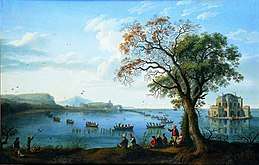Fusaro Lake
Coordinates: 40°49′N 14°03′E / 40.817°N 14.050°E

Lake Fusaro (Italian: Lago di Fusaro, Latin: Acherusia Palus, Ancient Greek: Ἀχερουσία λίμνη, translit. Acherousia limne) is a lake of the Campania region that is situated west of Naples, Italy, in the territory of the community of Bacoli. It is about 0.5 miles (0.80 km) from Baia, and about 1 mile (1.6 km) south of the acropolis of Cumae.[1] It is separated from the sea by a narrow coastal strip. It is a very unusual ecosystem of great interest, characterized by a variety of vegetation which is specific to the region.
Geography
Thanks to the presence of nearby fresh water springs, Lake Fusaro (known since the 3rd century B.C. as Acherusia Palus), has been known around the world for its great oysters. Mussels are also fished in quantity in the lake.
The lake is surrounded by a number of buildings, including the Royal Casina, the Ostrichina, the Grand Restaurant, the Pavilions (stables) and the Green Park, which were all part of a large business employing around 1,000 people at the beginning of the 20th century. Today, most of these buildings are not used for their original purpose, but still serve as tourist destinations.
Antiquity
The name appears to have been bestowed on it (probably by the Greeks of Cumae, for which it the lake may have been the harbour) in consequence of its proximity to Lake Avernus, when the legends connecting that lake with the entrance to the infernal regions had become established. On this account the name was by some applied to the Lucrine lake, while Artemidorus maintained that the Acherusian lake and Avernus were the same.[2][3] The Lago di Fusaro could never have had any direct connection with the volcanic phenomena of the region, nor could it have partaken of the gloomy and mysterious character of Lake Avernus. The expressions applied to it by Lycophron are mere poetical hyperbole;[4] and Virgil, where he speaks of "tenebrosa palus Acheronte refuso",[5] would seem to refer to Avernus itself rather than to this lake.
In the 1st century AD an artificial outlet was dug for it at its south end, with a tunnel, lined with opus reticulatum and brick, under the hill of Torregaveta. This hill is covered with the remains of a large villa, which is almost certainly that of Servilius Vatia, described by Seneca.[6] There are remains of other villas on the shores of the lake.[1]
Notes
- 1 2 Chisholm 1911, p. 368.
- ↑ Strabo. Geographica. v. pp. 243, 245. Page numbers refer to those of Isaac Casaubon's edition.
- ↑ Pliny. Naturalis Historia. 3.5.9.
- ↑ Lycophron, Alex. 695.
- ↑ Virgil. Aeneid. 6.107.
- ↑ Chisholm 1911, p. 368 Seneca Epist. 55.
- Attribution
![]()
![]()